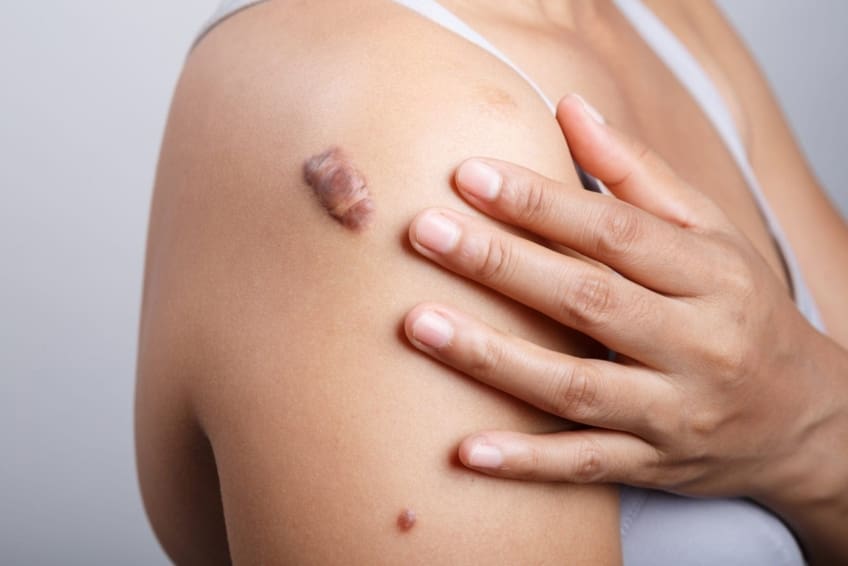
What are keloids?
Keloids are a type of raised scar. They occur where the skin has healed after an injury. They can grow to be much larger than the original injury that caused the scar. They are not at all common, but are more likely for people who have dark skin.
Anything that can cause a scar can cause a keloid. This includes being burned, cut, or having severe acne. Keloids can also develop after you get a body piercing, a tattoo, or have surgery. Keloids sometimes show up 3 months or more after your skin is injured. Some continue to grow for years.
Symptoms of keloids
Keloids can have the following characteristics:
- Appear and grow slowly. It can take 3 months up to a year before you see the first signs of a keloid. Then it takes weeks or months for it to grow. Sometimes, they continue to grow slowly for years.
- Begin as a raised pink, red, or purple scar. A keloid is usually a raised scar with a flat surface. The color tends to darken with time. It usually ends up being darker than the person’s skin, with the border being darker than the center.
- Feel different than the surrounding skin. Some keloids feel soft and doughy. Others are hard and rubbery.
- Cause pain, itching, or tenderness. When they are growing, some keloids may be itchy, tender, or painful to the touch. These symptoms usually stop once the keloid stops growing.
Keloids can form anywhere on the body. They are most common on the neck, shoulders, chest, back, and ears. They can range in size from smaller than an inch to 12 inches or more.
What causes keloids?
After your skin is injured, your cells try to repair it by forming a scar. In some people, the scar tissue keeps forming long after the wound heals. This extra scar tissue causes the raised area on your skin. Doctors still aren’t sure why some people’s skin scars this way.
Many different types of skin injuries can lead to a keloid. These include:
- cuts
- puncture wounds
- surgical scars
- severe acne
- chicken pox
- insect bites
- injection sites
- piercings
- tattoos
Some people are more likely to develop a keloid when they scar. You are more likely to develop a keloid if:
- You are Black, Latino, or Asian.
- You are younger than 30 years of age.
- You are pregnant.
- You are a teenager going through puberty.
- You have a history of keloids in your family.
People who have darker skin are 15% to 20% more likely to develop keloids.
How are keloids diagnosed?
Your doctor can diagnose a keloid by looking at the raised scar on your skin. Sometimes he or she may do a skin biopsy to rule out other types of skin growths.
Can keloids be prevented or avoided?
People who are more likely to get keloids may decide not to get a body piercing or tattoo. If you get your ears pierced, you should wear special pressure earrings to reduce scarring on your earlobes.
Treatment
The goal of treatment is to flatten, soften, or shrink the raised scar. Keloids can be hard to get rid of. Sometimes they return after treatment. Many doctors will use a combination of treatments for the best results. Treatments include the following:
- Corticosteroid shots. The medicine in these shots helps shrink the scar.
- Freezing the scar. Called cryotherapy, this can be used to reduce the hardness and size of the scar. It works best on small keloids.
- Wearing silicone sheets or gel over the scar. This can help flatten the keloid.
- Laser therapy. This can help flatten the keloid. It also can fade the color.
- Surgical removal. This involves cutting out the keloid. Most keloids will return after this treatment.
- Pressure treatment. After keloid surgery, keeping pressure on the area reduces blood flow. This can prevent a keloid from returning.
Different treatments work for different people. Talk to your doctor about which treatment option is right for you.
Living with keloids
Keloids are not harmful to your health, but having them can be upsetting to you. You may be embarrassed about how they look. This can hurt your self-esteem. Most people who get treatment for keloids do so because they don’t like the way they look. Luckily, the treatments that are available can improve the way the keloids look, even if they don’t get rid of the scars completely.
Questions to ask your Doctor
- Why did I get a keloid?
- I’m having surgery. What can I do to avoid keloids?
- What is the best treatment for my keloid?
- Will I need surgery to get rid of the keloid?
- Will an over-the-counter cream help?
- Should I avoid getting body piercings or tattoos?
- Will I need to take any medicines?
- What side effects could I experience from the medicine?
- Am I at high risk of developing keloids?
- Could the keloid come back?
Resources
![]()
Copyright © American Academy of Family Physicians
This information provides a general overview and may not apply to everyone. Talk to your family doctor to find out if this information applies to you and to get more information on this subject.






